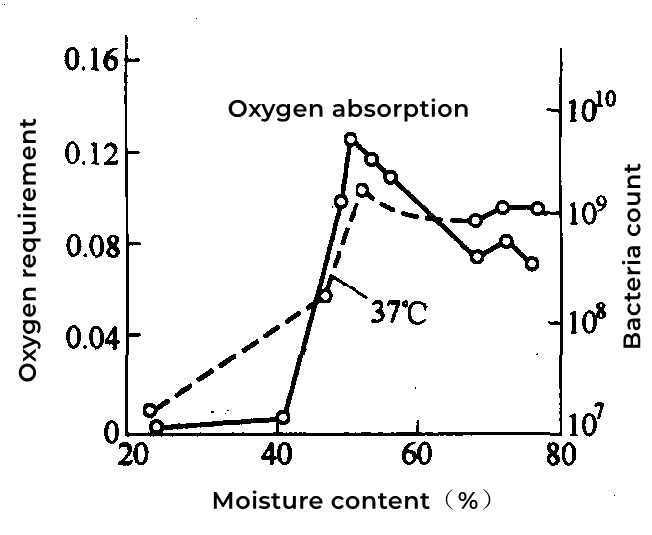Moisture is an important factor in the compost fermentation process. The main functions of water in compost are:
(1) Dissolve organic matter and participate in the metabolism of microorganisms;
(2) When the water evaporates, it takes away heat and plays a role in regulating the temperature of the compost.
So the question is, what is the right moisture for compost?
Let’s first look at the following chart. From the figure, we can see that the growth of microorganisms and the requirement for oxygen both reach their peaks when the moisture content is 50% to 60% because aerobic microorganisms are the most active at this time. Therefore, when composting with domestic waste, it is generally best to use a moisture content of 50% to 60% (by weight). When there is too much moisture, such as more than 70%, the air will be squeezed out of the raw material gap, reducing the free porosity and affecting the air diffusion, which will easily cause an anaerobic state and will cause problems in the treatment of leachate, resulting in aerobic microorganisms. No reproduction and anaerobic microorganisms are more active; and when the moisture content is less than 40%, the microbial activity decreases, the organic matter cannot be decomposed, and the composting temperature decreases, which in turn leads to a further decrease in biological activity.
Relationship between moisture content and oxygen demand and bacterial growth
Usually, the moisture content of domestic garbage is lower than the optimal value, which can be adjusted by adding sewage, sludge, human and animal urine, and feces. The weight ratio of the added conditioner to the garbage can be calculated according to the following formula:
In the formula, M——the weight (wet weight) ratio of the regulator to the garbage;
Wm, Wc, Wb——respectively the moisture content of mixed raw materials, garbage, and conditioner.
If the moisture content of household waste is too high, effective remedial measures should be taken, including:
(1) If the land space and time permit, the material can be spread out for stirring, that is, the evaporation of water can be promoted by turning the pile;
(2) Add loose or absorbent materials to the material, commonly used are: straw, chaff, dry leaves, sawdust and compost products, etc., to assist in absorbing water and increasing its void volume.
There are many methods for determining the moisture content. The conventional method is to measure the weight loss of the material at a specified temperature of 105±5°C and a specified residence time of 2 to 6 hours. The rapid test method can also be used, that is, the moisture content of the material is determined by drying the material in a microwave oven for 15-20 min. It is also possible to judge whether the moisture content is suitable according to some phenomena of the composting material: if the material contains too much water, in the case of open-air composting, leachate will be produced; during dynamic composting, agglomeration or agglomeration will occur, and even odor will be produced.
Regarding the moisture control and adjustment of compost material, the following general principles should also be followed:
① Appropriately lower in the southern region and higher in the northern region
② Appropriately lower in the rainy season and higher in the dry season
③ Appropriately lower in low-temperature seasons and higher in high-temperature seasons
④ The aged clinker is appropriately lowered, and the fresh ingredient is appropriately raised
⑤ Adjust low C/N appropriately and adjust high C/N appropriately
If you have any other questions or needs, please contact us by the following ways:
whatsapp: +86 13822531567
Email: sale@tagrm.com
Post time: Jul-13-2022


